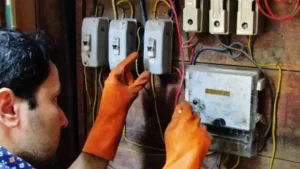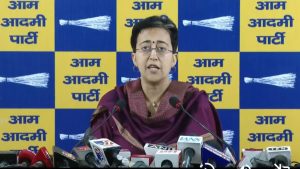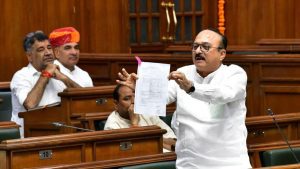New Delhi – In the middle of rising summer temperatures and increased electricity demands, frequent power cuts in Delhi have sparked a major political controversy. The Aam Aadmi Party (AAP) has accused the Delhi government of mismanagement, alleging that citizens are being forced to suffer recurring outages despite assurances of uninterrupted power.
However, the Delhi Power Minister rebutted the claims, stating that all the recent outages were “planned” maintenance shutdowns. The political narrative took a dramatic turn when independent data appeared to contradict these statements, pointing to frequent power cuts in Delhi not aligned with any publicly issued maintenance schedules.
Delhi Residents Struggle with Heat and Outages

Delhi’s early summer has already seen temperatures soar above 35°C, amplifying the public’s dependence on uninterrupted power for cooling appliances. But this has coincided with a noticeable increase in frequent power cuts in Delhi, frustrating residents across multiple zones, including Tilak Nagar, Janakpuri, and Dwarka.
Many citizens took to social media to express their anger, sharing videos and time-stamped photos documenting long hours without power. In several areas, even traffic lights went down due to outages, causing disruptions beyond just household discomfort.
AAP’s Allegations: Mismanagement and Lack of Transparency


Senior AAP leaders held a press conference to criticize the Delhi government’s power management policies. They alleged that:
-
Citizens were not informed in advance about the outages.
-
Multiple cuts happened in one day in some areas.
-
Restoration took longer than normal, indicating a crisis in response systems.
-
Government officials were downplaying the extent of the issue.
AAP accused the administration of deliberately suppressing outage reports and termed the frequent power cuts in Delhi as a result of “systemic failure and planning negligence.”
Government Response: ‘All Outages Were Planned’


In response, the Delhi Power Minister issued a statement clarifying that all power cuts were scheduled and part of essential infrastructure upgrades. According to the minister, the maintenance was pre-approved and aligned with Delhi Transco Limited’s operational schedule.
The minister emphasized that the outages were limited to a few hours and only affected certain circuits where transformers or substation upgrades were ongoing. He also claimed that the government has invested heavily in Delhi’s power infrastructure and pointed to data showing a decline in unplanned blackouts over the past year.
Still, the explanation failed to satisfy critics who insisted that frequent power cuts in Delhi went far beyond what was justified under maintenance.
The Data Dispute: What the Numbers Say
A closer look at real-time outage data and community feedback paints a more complex picture. Records from DISCOMs (Distribution Companies) and power monitoring platforms indicate that:
-
More than 25% of reported outages were unscheduled.
-
In certain sectors, blackouts lasted 3 to 4 hours, contrary to the official 90-minute limit.
-
Alerts about planned outages were not circulated through all official channels, including SMS and public notices.
This gap between official claims and actual consumer experience has fueled concerns about the accuracy of the “planned outage” narrative and exposed contradictions in the government’s version of frequent power cuts in Delhi.
Impact on Daily Life and Businesses
The ripple effects of these frequent power cuts in Delhi extend beyond domestic inconvenience:
-
Small businesses like salons and kirana stores reported loss of customers.
-
Students preparing for competitive exams struggled with online classes and study schedules.
-
Hospitals and clinics were forced to rely on backup power, incurring additional costs.
-
High-rise societies without backup generators faced elevator failures and water pump issues.
RWA (Resident Welfare Association) representatives in several localities demanded a formal audit of the city’s power distribution strategy and a grievance redressal system for outages lasting over one hour.
Is Delhi’s Power Grid Under Stress?
Experts say that Delhi’s grid is capable of handling a peak load of 8,000 MW, but aging infrastructure in some pockets is a concern. While planned maintenance is essential, the frequency and distribution of outages suggest deeper systemic issues.
The frequent power cuts in Delhi may also be attributed to:
-
Delayed completion of substation modernization projects.
-
Heat-induced equipment overloads.
-
Increased residential demand outpacing current capacity buffers.
The need for robust predictive maintenance and load balancing has become a critical talking point in ongoing policy discussions.
Political Fallout and Public Perception
As the political blame game intensifies, public confidence in the government’s ability to provide basic services has taken a hit. Opposition parties, including AAP, have called for a white paper on the current state of power supply in Delhi.
Polling data from local agencies reveals that over 60% of respondents in affected zones believe the government was unprepared for early summer demand. The frequent power cuts in Delhi have now become a rallying issue in upcoming civic elections.
Solutions Proposed and the Road Ahead
To address the issue, the following steps have been proposed by energy experts and civic groups:
-
Real-time Outage Tracking App for consumers to check planned vs unplanned cuts.
-
Community Alerts 24 hours before scheduled maintenance.
-
Redundancy Measures including mobile transformers and power vans.
-
Performance Audits of DISCOMs under the Right to Services Act.
-
Fast-tracking modernization of at-risk substations.
While these are positive steps, their success will depend on transparent implementation and consistent monitoring. The problem of frequent power cuts in Delhi cannot be solved overnight, but systematic efforts could rebuild public trust.
Closing Remarks: A Wake-Up Call for Delhi’s Power Policy
The controversy over frequent power cuts in Delhi has highlighted the critical importance of communication, transparency, and proactive infrastructure planning in managing urban utilities. Whether the outages were all planned or not, the gap between official statements and public experience has created a trust deficit.
As Delhi braces for peak summer months, swift corrective measures, accountability, and data-backed decision-making will be essential. Otherwise, the capital may face not just heatwaves, but a deeper political and civic storm sparked by something as basic — and vital — as electricity.

